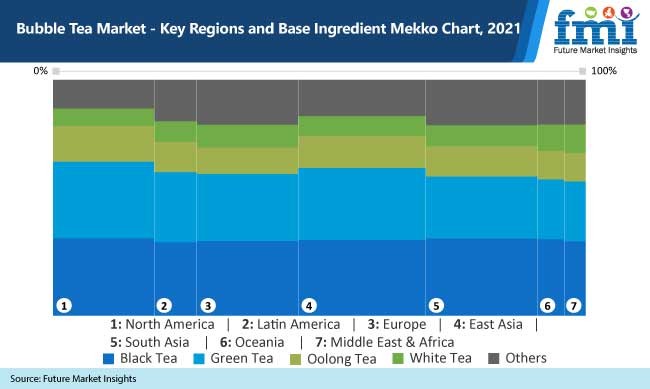According to the latest Future Market Insights (FMI), the global bubble tea market will report 8.8% CAGR between 2021 and 2031. Consumers across the world know bubble tea as bubble milk tea, boba juice, boba tea, or pearl tea. Bubble tea is made with common tea ingredients plus chewy tapioca balls, earning it the nickname “pearl tea.”
Availability of bubble in a variety of flavors, including peach, plum, mango, passion fruit, coffee, chocolate, and strawberry, depending on the flavour of the tapioca balls has made it hugely popular globally.
Request a Sample of this Report @ https://www.futuremarketinsights.com/reports/sample/rep-gb-12310
The chewy tapioca balls don’t have a lot of calories in them. According to studies, a 1.1 ounce serving of uncooked pearls contains 68 calories, but when tapioca balls are soaked in sugar mixture, their calorie count rises, potentially slowing the market’s growth.

As a result, numerous tea makers are shifting their focus to healthier versions of bubble tea with reduced fat and calorie content. Many are even using taglines to promote their products, emphasizing the antioxidant and anti-inflammatory effects of their bubble tea.
It is frequently sold at a low price to introduce customers to several flavors and encourage them to establish a bubble tea habit over time. Many brands add fruits and jellies to their bubble tea to cater to the dynamic consumer preference.
Key Highlights
- Global bubble tea market is estimated to reach US$ 2.3 Bn in 2021.
- In terms of the base ingredient, black tea, which will represents over 36% of the market by 2031, will remain dominant through the forecast period.
- On the basis of flavour, bubble tea market is segmented into original and flavored. In 2021, the flavoured bubble tea segment will represent 67.2% of the market.
- East Asia holds dominance in the global bubble tea market. Within East Asia, China will represent the largest market share.
- Within North America, the U.S. will hold dominance, accounting for a little over76% of bubble tea sold in the region.
“Bubble tea companies are attempting to strike the perfect balance between acquisition and retention, especially since small firms don’t have a lot of money to spend on marketing. Digital loyalty programs are used by brands because they can gather and utilize data at a minimal cost.” said a lead analyst at FMI.
Ask An Analyst @ https://www.futuremarketinsights.com/ask-the-analyst/rep-gb-12310
Social Media Influencing Choices of Customers, Especially Among Youth
Social media is full of advertisements, news, and other impactful visuals. Brands often use social media to target their consumers. Restaurants use social media to promote their drink specials and happy hours. Additionally, social media is where parties and get-togethers are organized. Because social media is such an integral part of people’s lives, it can also influence the way they drink.
It is unique platform where in that bubble tea brands can target consumers and create relationships with their audience. Users are often asked to “like” brands, to attend their events, and share photos of themselves using their products. In other words, social media is the perfect environment for bubble tea to be displayed, viewed, bought, and sold. Hence focus on social media penetration is expected to grow among market players.
Who is Winning?
Companies operating in the bubble tea market are focusing on expanding their footprint in developing markets. For instance:
- In 2017, Chatime was launched in Mumbai, India by Alchemist Foods Ltd from Taiwan. The store catered to provide freshly brewed bubble tea while penetrating the local beverages market
- Chatime Malay stated in January 2019 that it was planned to grow its presence aggressively into Singapore, the United States, India and Saudi Arabia as part of their five-year expansion strategy
Some of the leading companies offering bubble tea are Gong Cha, Kung Fu Tea, Lollicup USA, Tiger Sugar, Sharetea, Boba Guys, Tapioca Express, Cha Time, Tea Ren’s Tea Time, YiFang Bubble Tea, CoCo Fresh Tea & Juice, DaBoba, Happy Lemon, Quickly, Cojiitii, and othes.
Get Valuable Insights into Bubble Tea Market
Future Market Insights, in its new offering, provides an unbiased analysis of the bubble tea market presenting historical demand data (2016-2020) and forecast statistics for the period from 2021-2031. The study divulges compelling insights on the bubble tea market based on base ingredient (black tea, green tea, oolong tea, white tea, and others), flavour (original and flavored), sugar content (regular and reduced sugar/sugar free), format (ready-to-drink (rtd) and instant mixes), toppings (pearl, grass jelly, coconut jelly, red bean, and multiple/others), and by distribution channel (direct (B2B), indirect (B2C), and Online Retailing) across seven major regions.
Key Questions Answered in the Report
- What is the bubble tea market size?
- What is the most popular bubble tea flavor?
- What are the key trends shaping the bubble tea market?
- Who are the leading players in the bubble tea market?
- How was post-COVID bubble tea market performance?
- What is the North America bubble tea market outlook?
- What is the Europe bubble tea market outlook?
Buy Complete Report @ https://www.futuremarketinsights.com/checkout/12310
Contact Us:
Future Market Insights
Unit No: AU-01-H Gold Tower (AU), Plot No: JLT-PH1-I3A,
Jumeirah Lakes Towers, Dubai,
United Arab Emirates
For Sales Enquiries: sales@futuremarketinsights.com
For Media Enquiries: press@futuremarketinsights.com
Website: https://www.futuremarketinsights.com